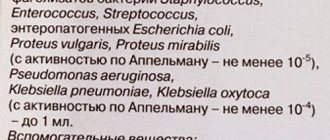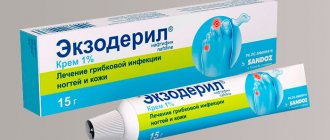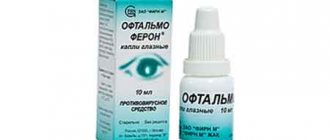Release form, packaging and composition of the drug Clinical-pharmacological group Pharmaco-therapeutic group Pharmacological action Indications for use Method of administration and doses Side effects Contraindications for use Use in children Special instructions Drug interactions
Registration Certificate Holder:
NPO MICROGEN, JSC (Russia)
ATX Code:
V03A
Active substance:
Dosage form:
Bacteriophage coliproteus
Release form and composition
The dosage form of release of Bacteriophage coliproteus is a solution for oral administration, local and external use: a transparent yellow liquid of varying intensity, may have a greenish tint (20 and 100 ml bottles, in a cardboard box 1 bottle of 100 ml or 8 bottles of 20 ml ).
Composition of 1 ml solution:
- active substance: a mixture of purified bacteriophages Proteus vulgaris (with an Appelman activity of at least 10-5), Proteus mirabilis (with an Appelman activity of at least 10-5) and enteropathogenic Escherichia coli of various serogroups (with an Appelman activity of at least 10-4) – up to 1 ml;
- auxiliary component: preservative 8-hydroxyquinoline sulfate or 8-hydroxyquinoline sulfate monohydrate.
In what cases should you not take the drug?
There are practically no contraindications for Bacteriophage Coliproteus. This medicine should only be taken by people with hypersensitivity to any of its components. Sometimes patients may experience allergic reactions to this drug. In this case, treatment using this remedy should be discontinued.
During pregnancy, treatment with Bacteriophage coliproteus is allowed. However, women expecting and breastfeeding are allowed to take it only after consultation with their doctor and under his supervision.
Indications for use
According to the instructions, Bacteriophage coliproteus is used for the prevention and complex therapy of dysbiosis, enteral and purulent-inflammatory diseases caused by enteropathogenic Escherichia coli and Proteus bacteria:
- generalized septic diseases;
- surgical infections (carbuncles, boils, phlegmon, hidradenitis, wound suppuration, paraproctitis, abscess, panaritium, burns, bursitis, osteomyelitis, mastitis);
- diseases of the ENT organs, respiratory tract and lungs (inflammation of the sinuses, pharyngitis, tracheitis, tonsillitis, laryngitis, middle ear, bronchitis, pneumonia, pleurisy);
- intestinal dysbiosis, enteral infections (gastroenterocolitis, cholecystitis);
- urogenital infections (cystitis, urethritis, pyelonephritis, salpingo-oophoritis, endometritis, colpitis);
- purulent-inflammatory diseases of newborns (including pyoderma, omphalitis, conjunctivitis, gastroenterocolitis and sepsis);
- other diseases caused by Proteus or Escherichia coli.
Drug analogues
If necessary, this drug, of course, can be changed to some other drug. The cheapest analogue of “Bacteriophage coliproteus” is “Dioxidin”. This drug can be prescribed to patients to treat inflammatory infectious processes if antibiotics do not have the desired effect.
The main advantage of Dioxidin, in comparison with Bacteriophage coliproteus, is its low cost. The disadvantages of this drug include, first of all, the fact that it cannot be used during pregnancy, even under the supervision of a doctor.
The most popular analogue of “Bacteriophage coliproteus” is “Monural”. This modern antibiotic can be used to treat, for example, cystitis, urethritis, postoperative inflammation of the urinary tract, etc.
Also analogues of this drug are Nitroxoline, Uronormin-F, Kirin, Amizolid and some others.
Instructions for use of Bacteriophage coliproteus: method and dosage
Before prescribing Bacteriophage coliproteus, the phage sensitivity of the pathogen should be determined.
The solution is used for oral administration (orally), for rectal administration (in the form of enemas), administration into the nasal cavity, sinuses, vagina, uterus, wounds and drained cavities, in the form of applications and irrigations.
Recommended doses of Bacteriophage coliproteus depending on the age of the patient, for oral/rectal administration:
- 0–6 months: 5/5–10 ml;
- 6–12 months: 10/10–20 ml;
- 1–3 years: 15/20–30 ml;
- 3–8 years: 15–20/30–40 ml;
- from 8 years and older: 20–30/40–50 ml.
For purulent-inflammatory diseases with localized lesions, Bacteriophage coliproteus is indicated for use simultaneously topically and orally. The course of treatment, depending on clinical indications, can last from 7 to 20 days.
Wounds treated with chemical antiseptics must be thoroughly washed with a sterile solution of sodium chloride 0.9% before applying the bacteriophage.
Methods of using Bacteriophage coliproteus:
- irrigation, lotions, tamponing: up to 200 ml of solution depending on the size of the affected area. For osteomyelitis, the drug is poured into the wound in a dose of 10–20 ml after appropriate surgical treatment. In case of an abscess, the bacteriophage is administered by puncture after removing the purulent contents in a slightly smaller quantity than the volume of pus;
- rinsing, washing, instillation, administration of moistened turundas: 2–10 ml of the drug 1 to 3 times a day for purulent-inflammatory diseases of the nose, throat and ear. After administration, turundas soaked in the solution are left for 1 hour;
- injection into the cavity of the vagina and uterus: in an amount of 5–10 ml of solution once a day for purulent-inflammatory gynecological diseases, for colpitis - 10 ml 2 times a day by irrigation or tamponing (tampons are placed for 2 hours);
- administration into limited cavities (including articular and pleural): in an amount of up to 100 ml of the drug. Then a capillary drainage is left and the solution is administered through it for several more days;
- orally for diseases of the urinary tract. In case of drainage, the bacteriophage is injected into the bladder through the cystostomy, 20–50 ml 1-2 times a day, into the renal pelvis - through the nephrostomy, 5–7 ml 1-2 times a day;
- orally for intestinal dysbiosis and enteral infections: 1 hour before meals 3 times a day. A combination of oral administration of the drug 2 times a day with rectal administration in the form of an enema after bowel movement once a day is also allowed.
Use of Bacteriophage coliproteus in children under 6 months of age
For infected wounds, pyoderma and omphalitis, the drug is used 2 times a day in the form of applications: a gauze cloth is moistened in the solution and applied to the affected area or umbilical wound.
For enterocolitis and sepsis in newborns, including premature babies, the drug is used in the form of high enemas (through a catheter or gas tube). The recommended dose is 5–10 ml, the frequency of procedures is 2 or 3 times a day. If the child does not spit up or vomit, the solution can be administered orally (mixed with breast milk). A combination of oral and rectal administration of the drug is also possible. The duration of treatment is from 5 to 15 days. In cases of relapse of the disease, repeated courses are carried out as prescribed by the doctor.
To prevent enterocolitis and sepsis in case of intrauterine infection or the risk of developing nosocomial infection in newborn children, Bacteriophage coliproteus is prescribed in the form of enemas 2 times a day for 5–7 days.
What is the drug bacteriophage?
This is a transparent yellow solution, which, depending on the type of phage and the disease, is prescribed orally, rectally in the form of enemas, locally in the form of washings, instillations, lotions, rinses, moistened turundas, injection into the pleural, articular cavity, bladder cavity, uterus, etc. vagina.
If necessary, phages are used in nebulizers, but not ultrasonic ones.
Among bacteriophages there are especially popular ones. These are Staphylococcal bacteriophage, Pyobacteriophage, Sextaphage.
Sextaphage, for example, is often prescribed for sinusitis, prolonged green snot, laryngitis, tonsillitis, purulent conjunctivitis, absence of stool in a newborn, bloating (if microbes sensitive to the phage, for example, staphylococcus, are inoculated).
special instructions
It is necessary to shake the bottle before each use of the bacteriophage.
The drug contains a nutrient medium favorable for the development of bacteria from the environment (manifested by turbidity of the solution). For this reason, when opening the bottle, you should strictly adhere to the following aseptic rules:
- wash your hands thoroughly;
- treat the cap with an alcohol solution;
- remove the cap without opening the stopper;
- if the cork is opened, do not place it inside on any surface;
- when using small doses, draw the solution from the bottle with a disposable sterile syringe;
- close the bottle immediately after taking the required amount of solution;
- After opening, store the bottle only in the refrigerator.
If the recommended storage conditions are observed and the solution is not cloudy, the opened bottle can be used for the entire expiration date specified by the manufacturer.
It is forbidden to use a cloudy drug!
Impact on the ability to drive vehicles and complex mechanisms
There is no information about the negative impact of the drug on human cognitive and psychomotor functions.
Reviews of “Bacteriophage coliprotein”
Patients have simply excellent opinions about this drug. This medicine works, judging by the reviews of patients, it is actually very effective. Another undoubted advantage of the drug is its safety. This remedy does not give any side effects.
Most patients consider the not very pleasant smell to be a drawback of the medicine. Also, among the minor disadvantages of the product, many patients attribute its rather high cost - about 600-700 rubles. per bottle.
Tips for selling bacteriophage
1. Together with the buyer, count the number of bacteriophage packages per course.
2. To begin with, release the number of packages for 1-2 days to see individual tolerance. Tell the buyer that if tolerated well, he should come back for the remaining packages, otherwise the money will be wasted and the treatment will be ineffective.
3. Don’t forget to offer disposable 5 or 10 ml syringes for withdrawing the required amount of phage from the vial and alcohol (salicylic, chloramphenicol, boric) to wipe the rubber stopper of the vial.
4. Warn that the bacteriophage is stored in the refrigerator.
5. Before use, especially in the form of drops or rinsing, the syringe with the collected phage should be held in your hand for several minutes.
6. Tell them that if the solution becomes cloudy or if any inclusions appear, it cannot be used.
That's all for me. I hope that the article was useful to you.
Let me remind you that we have a VKontakte group. It is intended for pharmacy employees ONLY. If you are a pharmacy employee, join us!
All my books for pharmacy employees are collected here.
See you again on the blog “Pharmacy for Humans”!
With love to you, Marina Kuznetsova
Sextaphage
(polyvalent pyobacteriophage)
FSUE NPO Microgen, Ministry of Health of the Russian Federation, Russia
- Release form:
20 ml bottle No. 4. - Area of application:
treatment of boils, carbuncles, hydroadenitis, abscesses, purulent-complicated wounds infected with staphylococci, purulent tonsillitis, bronchitis, pleurisy, bursitis, thermal burns, chronic osteomyelitis, phlegmon, tendovaginitis, mastitis, cystitis, cholecystitis. For deep infiltrated and abscessed staphylococcal sycosis, enterocolitis, etc., as well as for prophylactic purposes: for freshly infected wounds (surgeries in the abdominal and thoracic cavities, street and industrial injuries, etc.). - Antibacterial activity spectrum:
Pseudomonas aeruginosa, Proteus mirabilis, Proteus Vulgaris, Klebsiella pneumoniae, Staphylococcus, Streptococcus, enteropathogenic Escherichia coli.
detailed instructions
When are bacteriophages prescribed or can they be prescribed?
1. When the pathogen is resistant to all antibiotics.
2. For nosocomial infections. These are infections that occur in a hospital setting. The microbes that cause them have developed resistance to most antibiotics during their stay in hospital rooms. Thousands of patients die every year from diseases that, according to all medical canons, are perfectly treated.
3. If there are contraindications to most antibiotics.
4. If you are allergic to all antibiotics.
And…
1. Pregnant, lactating, newborns.
2. For mild infections, when you can do without an antibiotic, but you cannot do without antibacterial therapy.
3. Elderly people with a bunch of chronic diseases.
4. Together with an antibiotic to reduce its dose or increase its effectiveness, since the bacteriophage will also act on bacteria resistant to this antibiotic.
Bacteriophages as enemies of pathogenic microflora
By its nature, a bacteriophage is a virus and behaves accordingly. This is a non-cellular form of life, which in the external environment has the appearance of non-living crystals. An intracellular parasite that, once on the surface of a bacterial cell, “injects” its RNA into it, dissolving the cell membrane. The bacterium begins to produce hereditary virus material that is unusual for it, from which a new viral particle is assembled.
Soon, newly formed bacteriophages (100-200 pcs.) leave the affected cell, tearing it apart and causing death. It is no coincidence that “bacteriophage” is translated as “bacteria eater.” After the “army of bacteria” is completely destroyed, bacteriophages are noticeable for 5 days and then leave the body.
Types of bacteriophages
There are two types of bacteriophages:
1. Against different strains of the same pathogen: staphylococcal, streptococcal, dysentery, etc.
2. Against two or more pathogens: Sextaphage, Intesti-bacteriophage, Piobacteriophage, etc.
Let me explain a little.
Ideally, for each disease, it is necessary to identify the pathogen and determine its sensitivity to bacteriophages.
In practice, it happens that there is no time to wait. Therefore, “cocktails” of bacteriophages are created that act on different types of bacteria or on different strains of the same bacterium.
These are the “polyvalent” bacteriophages: Sextaphage, Pyobacteriophage, Klebsiella polyvalent bacteriophage, etc.
In such a “cocktail”, different bacteriophages feel great, do not fight and do not interfere with each other in dealing with their bacteria.
Today there are not so many bacteriophages:
When I began to understand this topic, I wrote to Microgen, naively believing that they would answer my questions, of which I had accumulated many.
For example:
- Why are some bacteriophages called polyvalent and others complex? What's the difference?
- Why is there no word “polyvalent” in the name “Intesti-bacteriophage”, although it acts on several bacteria?
- Why do some have the word “purified” in their names, while others don’t?
- What is the difference between Piobacteriphage polyvalent and Sextafag, if they act on the same bacteria?
But they didn’t answer me. Maybe they were afraid that some of my questions would be followed by others, and they would not be able to answer them? I'm digging deep.
Moreover, I noticed that after my letter to them, information about several bacteriophages disappeared from the site. For example, about the Klebsiella pneumoniae bacteriophage.
What does it mean?
Does this mean that it has ceased to be produced, and it can be replaced with Klebsiella polyvalent bacteriophage, Piobacteriophage or Sextaphage, which also act on this pathogen?
Well, God be with them.
Let's return to the table.
What conclusion can be drawn from this?
Recently in our VKontakte group there was a question about whether it is possible to replace the Klebsiella pneumonia bacteriophage with purified polyvalent Klebsiella bacteriophage?
In theory it is possible. Especially if the patient was not tested for sensitivity to the bacteriophage, but the pathogen Klebsiella pneumonia was simply cultured.
But given that this bacteriophage was prescribed by a doctor, a non-synonymous replacement cannot be made.
Correct use of drugs
Preparations based on bacteriophages are unusual, since they contain living particles inside, which is why it is so important to follow the rules for their use. The contents of the bottle should be transparent when exposed to light and not contain flakes or sediment.
If turbidity appears, do not use the product. It is advisable not to open the bottle and store it in the refrigerator. If necessary, make a puncture with a needle and inject the contents into the syringe in the required quantity. After the expiration date, use is pointless.
Medicine based on bacteriophages is a new word in medicine. This is a biological treatment method that helps get rid of the disease by destroying some parasites with the help of others. Biotechnological laboratories and industries are creating new complex “live” medicines that rid the body of infection without side effects.
Who is to blame for this?
Doctors who unreasonably prescribe antibiotics or run YouTube channels “for everyone,” where, in order to increase their popularity, they name specific antibiotics for specific diseases. The deplorable state of our domestic medicine with its catastrophic shortage of doctors and ill-conceived organization of outpatient care. Sometimes it is easier to get an appointment with the Queen of Great Britain than with a doctor
Therefore, people are forced to go online and prescribe their own treatment, including antibiotics. The Internet, where articles in most cases are written by copywriters - people without medical education who do not understand the importance and seriousness of what they write about.
Pharmacy staff who readily recommend antibiotics.
And don't tell me there isn't such a thing!
The other day I went to a group for pharmacy employees, and there one man asked how to treat ureaplasma (although it is not the microbe that needs to be “treated,” but the disease).
See what your colleagues write:
Friends, this is crazy!!!
With this state of affairs, it won’t be long until we have no antibiotics left, to which microbes are sensitive. The mortality rate will increase many times over!
I urge you, no, I BEG you: do not recommend antibiotics!
And I urge group administrators to at least sometimes use their brains and DELETE such information. She talks about the UNPROFESSIONALISM of pharmacists and pharmacists, since they do not know the principles of rational antibiotic therapy.
You and I work in the most fragile area of human life: health. Let us always remember the main commandment of medicine “DO NO HARM!”
How does a bacteriophage work?
There are signaling proteins (receptors) on the surface of bacteria. These proteins are different for different bacteria and even strains of bacteria. Each phage can detect only one type of signaling protein. This means that it can only infect a certain strain of bacteria.
The bacteriophage attaches to the bacterial cell using landing legs and, like a syringe, injects DNA into it from its head.
From this moment on, the bacterium disappears as an individual.
She stops eating, sharing, doing her dark deeds.
She becomes a slave, Isaura, a factory for the production of small cute viruses (young bacteriophages) and, with the help of her resources, begins to synthesize everything necessary for the assembly of new viral particles.
Eventually, there are so many of them, and the bacteria have so few resources that it bursts like a New Year's cracker, and newborn phages go free to search for new victims.
Look:
IMPORTANT:
If the bacteriophage does not find its signaling proteins, it will not attack the bacterium. It is strictly specific.
This leads to the following conclusion:
Rules for the use of bacteriophage preparations.
There are several rules for using the bacteriophage drug:
Before use, shake the bottle and see if there is any sediment; if sediment is observed, then the bacteriophage is not suitable for use.
Since the bacteriophage solution is stored in the refrigerator, it has a correspondingly much lower temperature compared to, say, room temperature, so it is unacceptable to use it cold. To heat the bacteriophage solution, you can leave the unopened vial for a while at room temperature or, which is much faster, warm it in your hand. But at the same time, it is necessary to warm the dose volume that you are going to use. To do this, use a syringe or pour the required amount of bacteriophage from the bottle into a small thin-walled glass or a smaller bottle and hold it, holding it in the palm of your hand until you feel that the bottle (glass) has acquired a different temperature.
Due to the fact that the drug contains a nutrient medium, if it is not opened carefully, microorganisms from the environment may get inside the bottle, which will cause spoilage or clouding of the drug, therefore it is necessary to wash your hands thoroughly, wipe the cap with an alcohol-containing liquid, remove the metal cap without touching it rubber stopper (do not remove along with the stopper).
Without opening the cap (by piercing the rubber stopper with a needle), you can take the required dose with a sterile syringe and pour it into a clean container (a glass or a smaller bottle), but only the dose that needs to be consumed (you cannot pour the remaining solution back into the original bottle).
If you remove the rubber stopper, do not place it with its inner surface on a table or other objects.
After taking the required dose, close the bottle with a rubber stopper, do not store it open, store only in the refrigerator at the specified temperature.
You can drop the bacteriophage solution using an ordinary, cleanly washed pipette, but do not lower the pipette into a common bottle, but pour the required amount of phage into another container.
When rinsing the mouth and throat, the bacteriophage foams strongly, so it is taken into the mouth in small doses.
The bacteriophage preparation can be diluted with boiled water (room temperature) up to twice as much if necessary (for example, in order to check for adverse reactions to the drug: rashes, nausea - especially in children in the first months of life). But diluting the bacteriophage with water must be justified, since this changes the concentration of the number of phages in the solution, and several dozen phages are needed to lyse even one bacterium.
Reproduction of the bacteriophage in the body occurs within 30 minutes and this is a chain reaction that lasts until not a single bacteria remains in a given area, so it takes at least an hour for the bacteriophages to begin to act.
The bacteriophage solution is used for prophylactic purposes or clinical treatment of various bacterial infections. These diseases can be either purulent-inflammatory or enteral, but the main condition for use is the presence in the body of bacteria of the genus for which this type of bacteriophage is “targeted”, and the strains of which are pre-sown during bacteriological studies.







